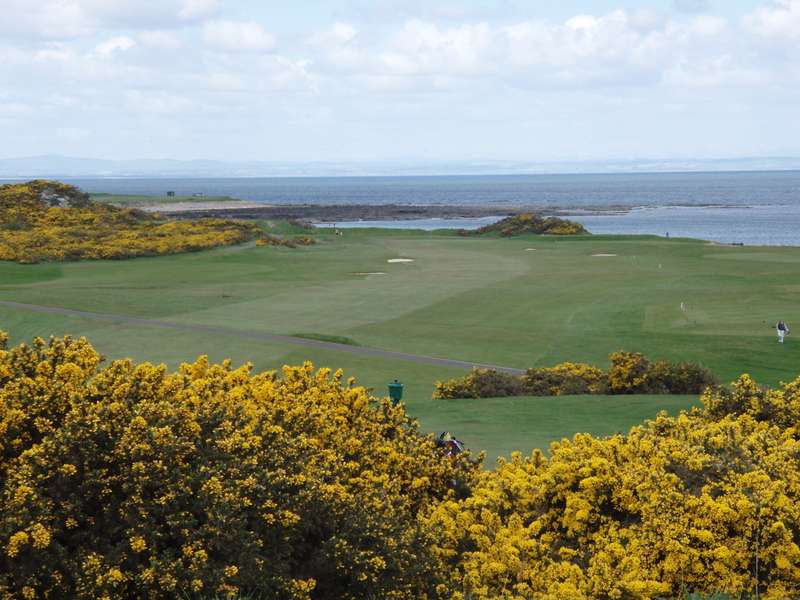The beauty of the course is evident from the moment you step onto the first tee. The picture above shows the opening hole (left) and 14th (right) in the foreground, with the par five 2nd skirting the eroding shoreline in the distance
How much of the beach - which is out of bounds rather than a hazard - do you dare cut off with your tee shot at the 4th?
The 10th is arguably the best hole on the course, with smart decisions and well executed golf shots - the approach shot from a sidehill lie - required to earn a three or four
With the gorse flowering in May, there are few better views in golf than from the tee of the 17th, and with the wind into you, probably few tougher pars
Course name: Crail (Balcomie)
Location: Crail, Fife, Scotland
Four Word Course Review: Unconventional, delightful holiday golf
The rich and lengthy history of Great Britain never ceases to amaze me. Case in point: The Crail Golfing Society is older than the country I grew up in! When Captain Arthur Phillip led the first fleet ashore in Sydney in January 1788, the golfers at Crail had already been playing as an organised society for two years.
The Balcomie links at Crail didn't follow until 1859, with the rudimentary course refashioned in 1895 (still five years before the settlers in Australia's colonies got around to Federating and becoming a proper country...) when Old Tom Morris laid out nine holes. He returned in 1899 to extend the course to 18 holes.
111 years later, what stands on the shore of the North Sea is a great example of what holiday golf should be.
Crail's Craighead links, designed by American Gil Hanse in 1998, provides the club with a "championship" course and the Balcomie remains a delightful, if not monumentally taxing (though 2-5 and 16-18 have some serious teeth), way to spend a few hours playing golf by the seaside, with the water visible from every hole on the course.
There are many remarkably memorable shots out there, including heroic drives across the beach at the 2nd, 4th and 5th (although there was an element of sameness about the latter two), while the semi-blind par three 3rd along a clifftop would hold its own on any course.
I also enjoyed the ridges that cross in front of the green at the short par four 1st and 7th, adding some spice to otherwise straightforward short approach shots, and the options and strategy of the 9th, dominated by the most fearsome bunker on the course guarding the green - and all that's just in the first nine holes.
It's a quirky layout, encapsulated by the unconventional back nine of 4, 5, 5, 3, 3, 4, 3, 4, 3. Despite so many back-to-back holes of the same par, there's no sameness.
The 10th starts the back nine in great style with a gentle downhill drive to a fairway that will kick everything left. The goal is to have your drive come to rest between the centreline bunker and the left rough, providing the best angle for the steeply uphill approach off a hook lie to a plateau green.
The two three-shotters play in opposite directions up and then down the same hill, the 11th to a skyline green and the 12th crossed by a burn that dominates the second shot whether you're going for the green or laying up. The 12th green has a fantastically bold ridge running up its centre that makes the approach perhaps the most important on the course to hit on the correct line.
After the steeply-uphill 13th and postcard 14th, which plays down to the shadows of a historic lifeboat station over a vicious front bunker, the course disappears around the corner for a thrilling finish, overlooked by the club's brand new clubhouse - its floor-to-ceiling windows making the dining room a great place to watch the field try to hold their cards together.
The 15th is reachable in one lusty blow, but the ocean laps at the left side of the green and sand is everywhere on the right. You then face a likely long iron, unless the wind favours you strongly, uphill over gorse at the 16th - one of many holes in these Isles named Spion Kop.
The closing two holes each vie for the title of toughest on the Balcomie links. A punishing par four and yet another par three over gorse to a steep green that offers very few easy two-putts.
The great quality of the Balcomie to me was just how thick and fast the thrills kept coming. It may not - in a technical breakdown - compete with the very best in Fife but that's fine because it's not a course that's trying to go toe to toe with the likes of The Old Course or Kingsbarns.
What the Balcomie does, it does very well. There are many championship courses that belt notchers are keen to play in Scotland, but any itinerary concerned with fun and variety should include this golf course. I defy anyone to regret experiencing it.
Sunday, May 16, 2010
Subscribe to:
Post Comments (Atom)




Tough two putt on 18, huh? Is that personal experience talking?
ReplyDeleteYou bet! It's an easy three-jab from six feet though...
ReplyDelete